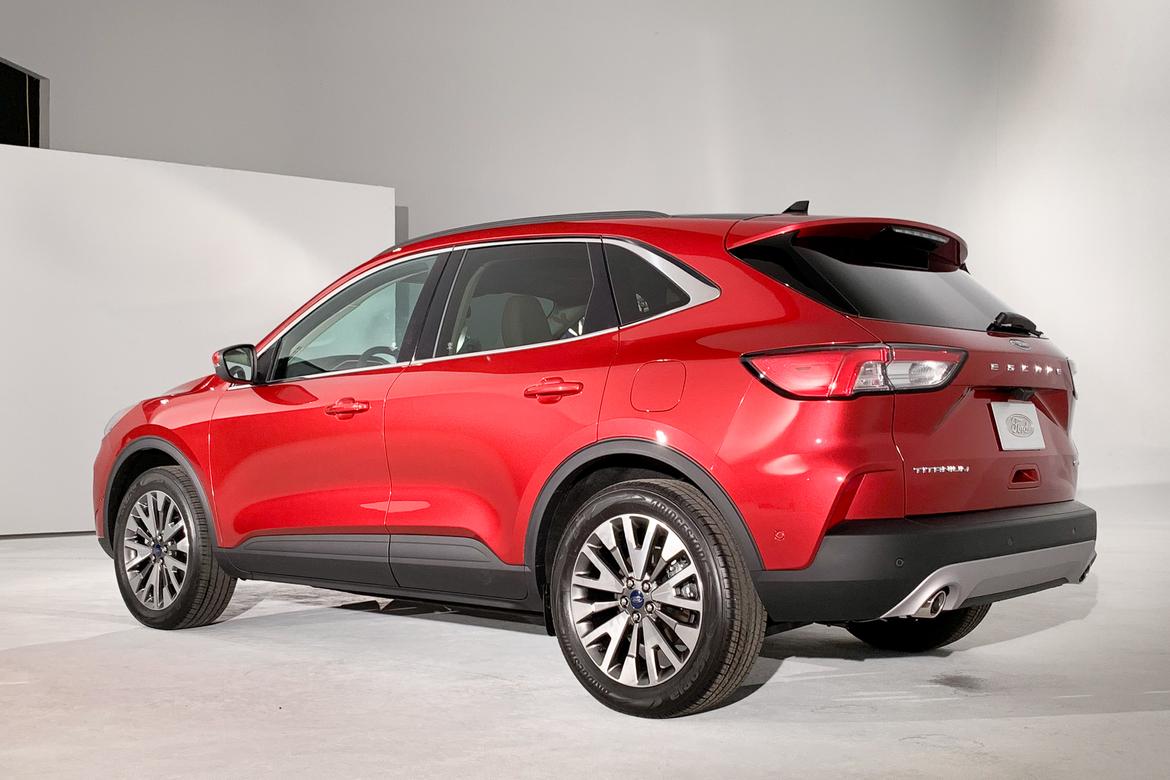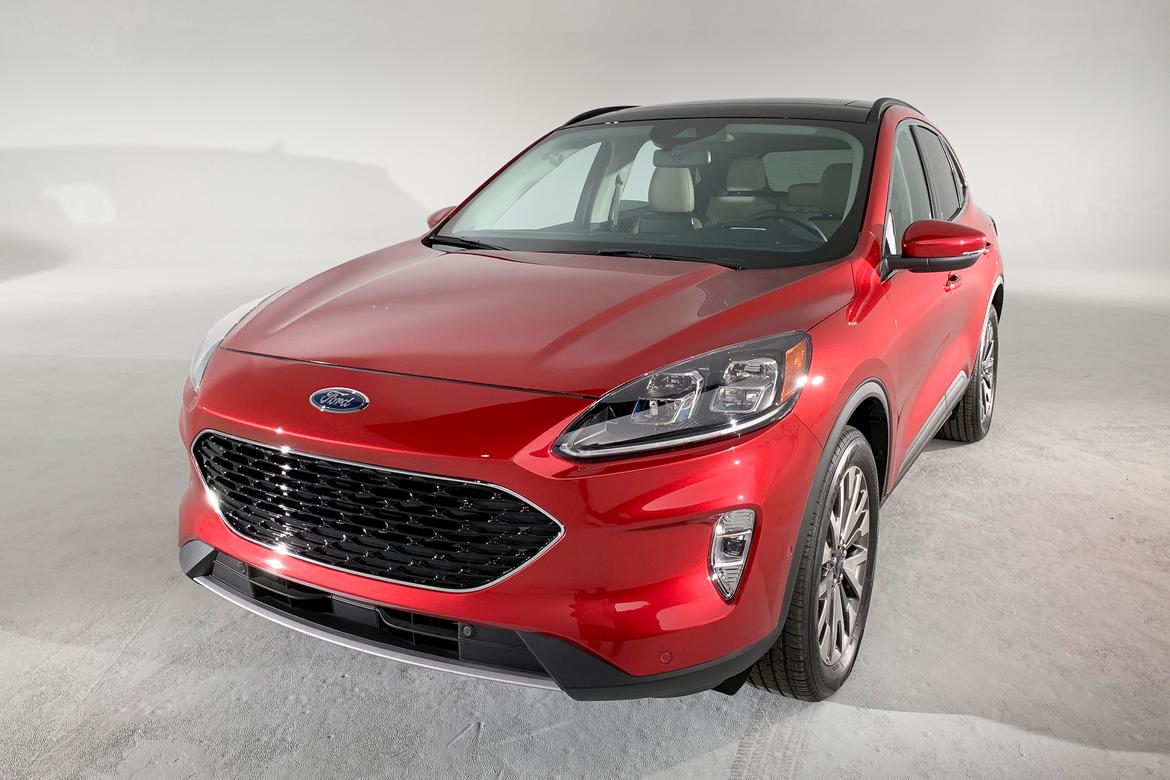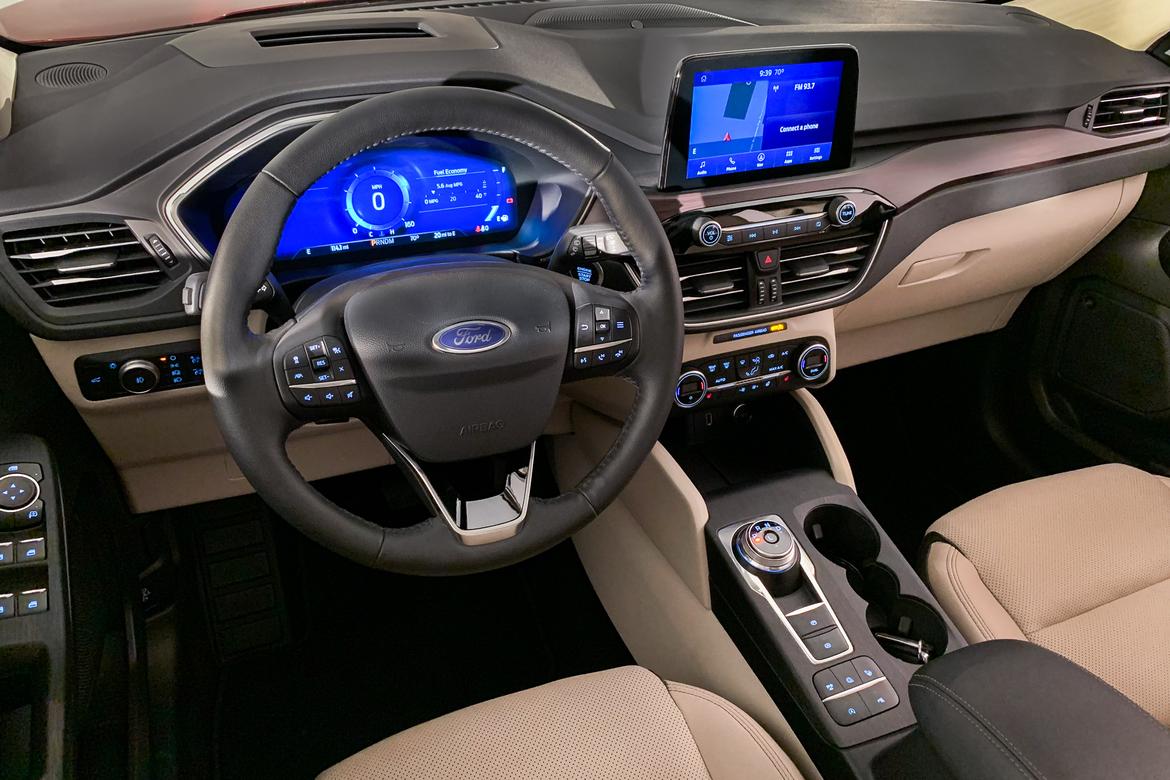Competes with: Chevrolet Equinox, Honda CR-V, Nissan Rogue, Toyota RAV4
Looks like: A cleaner, sleeker Escape with plenty of luxe SUV cues
Drivetrains: 180-horsepower, turbocharged 1.5-liter three-cylinder or 250-hp, turbo 2.0-liter four-cylinder, both with eight-speed automatic transmissions; Escape hybrid, plug-in hybrid have 2.5-liter four-cylinder with electric motor and continuously variable automatic-style transmission that makes 198 hp (hybrid) or 209 hp (PHEV); front- or all-wheel drive
Hits dealerships: Fall 2019; PHEV arrives spring 2020
If you wondered why the Ford Escape was conspicuously missing in Cars.com's just-published 2019 Compact SUV Challenge, it's because Ford had a redesign of its popular SUV just 'round the corner. Said corner has been rounded: Today, Ford unveiled the redesigned, fourth-generation Escape.
Set to arrive in the fall for the 2020 model year, the new Escape carries engines of the same displacement as its predecessor, but it shares new underpinnings with the not-for-America Focus redesign and Lincoln's forthcoming Corsair. (Lincoln is Ford's luxury division.) For the first time since 2012, Ford will also offer an Escape Hybrid, on sale at the same time as the regular Escape. Come spring 2020, the lineup will add its final piece in the Escape Plug-in Hybrid, also sold as a 2020 model. With those four available drivetrains, the Escape will come in five trim levels: S, SE, SE Sport, SEL and Titanium.
2019 Ford Escape Specs & Reviews
Find a 2019 Ford Escape Near You

Cars.com photo by Aaron Bragman
Exterior
If you mourn Ford's cancellation on a stateside version of the redesigned Focus, the Escape should cheer you up: It looks the part of a taller, cleaner Focus hatchback. The bumpers are light on visual clutter, at least in the example Ford showed at a preview event, and the hood-hugging headlights sit above the same low, six-sided grille.
Ford claims the redesign is lower, wider and longer. The longer hood lends a sort of cab-rearward stance you often don't get on a front-drive platform, and elements in back play up the newfound width. Slimmer taillights sprawl across a wider portion of the liftgate, with the SUV's name in widely spaced block letters between them. At the lower corners sit vertical reflectors inside bumper cutouts. Gray cladding encircles the lower reaches of the car, with a character line on the doors that's so prominent you might fear it's a dent. (On the flip side, that might help to hide the real thing.)
Interior
The dashboard is more EcoSport than Explorer, but that doesn't necessarily portend lackluster qualities elsewhere. The base S trim has a 4-inch multimedia display, while others get a tabletlike 8-inch touchscreen with Apple CarPlay and Android Auto. It perches above two rows of controls separated by air vents. In lieu of traditional gauges, a 12.3-inch digital instrument panel is optional; so is a head-up display and Bang & Olufsen premium audio.
The glove compartment doesn't appear to extend as far forward as it did in the prior Escape, something front passengers might appreciate. Despite a rotary electronic gear selector that replaces the outgoing model's conventional shifter — a development with space-saving potential — the console doesn't appear to have as many open nooks to stash items as the old Escape's did. Still, Ford claims an increase in overall interior storage space. The backseat folds in a 60/40 split and slides forward and backward, with a claimed best-in-class rear legroom and enough cargo space to fit a full-size dog crate. Ford also says the lithium-ion batteries in the Escape Hybrid don't compromise passenger or cargo space.
Cars.com photo by Aaron Bragman
Under the Hood
The outgoing Escape was one of the heavier members of its class, so it's welcome news that the redesign trims some 200 pounds' curb weight, according to Ford. Such slimming should aid fuel economy and performance, as should an eight-speed automatic transmission that replaces last year's six-speed unit. Indeed, Ford says the top-performing engine — a turbocharged 2.0-liter four-cylinder with 250 horsepower and 275 pounds-feet of torque — is 10 percent quicker than the outgoing turbo 2.0-liter Escape.
The 2.0-liter four-cylinder is available on the Escape Titanium. Lower trims get a turbo 1.5-liter three-cylinder (180 hp, 177 pounds-feet of torque) that adds cylinder deactivation for 2020. The Escape Hybrid, available in SE Sport and Titanium trims, combines a 2.5-liter Atkinson-cycle engine with an electronically variable transmission for a total 198 hp and 153 pounds-feet of torque. Ford projects the Escape Plug-in Hybrid, meanwhile, to make 209 hp and 153 pounds-feet, and capable of "more than 30 miles" of all-electric range. If the EPA corroborates such claims, Ford would edge out PHEV versions of the Kia Niro (26 miles), Subaru Crosstrek (17 miles) and Mitsubishi Outlander (22 miles).
All-wheel drive is available on the 1.5-liter and 2.0-liter models, as well as the Escape Hybrid; the Escape Plug-in Hybrid is front-drive only. Maximum towing capacity tops out at 2,000 pounds for the 1.5-liter Escape and 3,500 pounds for the 2.0-liter model. EPA mileage for all drivetrains is pending.
More From Cars.com:
- 5 Ways Ford Could Make a Great Escape (and a Couple Things to Leave Alone)
- What’s the Best Compact SUV of 2019?
- 2019 Compact SUV Challenge: How Do the CR-V, Rogue and Others Compare to the Tiguan?
- How We Found the Best Compact SUV of 2019
- 2020 Ford Explorer: Back to the Future
Safety and Autonomy
The Escape gets as standard equipment Ford's Co-Pilot360 suite of safety features, which includes blind spot and lane departure warnings, the latter with steering intervention, as well as auto high-beam headlights and automatic emergency braking with pedestrian detection.
Available technologies include adaptive cruise control down to a stop and lane-centering steering. Available automatic parking can steer the Escape into a spot and work the gas, brakes and gear selector — items the driver needed to manage in prior versions of the system.
Editor's note: This story was updated April 2, 2019, to amend the cylinder count of the 1.5-liter engine.
Source: Read Full Article


